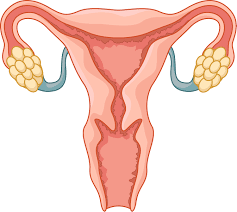Endometriosis is a painful disorder in which tissue that normally lines the inside of the uterus (Endometrium). Endometriosis most commonly involvesthe ovaries, fallopian tubes and the tissue lining of the pelvis. Rarely, endometrial tissue may spread beyond pelvic organs. This repeated irritation leads to the development of scar tissue and adhesions in thearea of the endometrial implants.

Causative factors for Endometriosis:
The exact cause of endometriosis is not currently fully understood. Endometriosis is a chronic condition that causes painful or heavy periods.
- Retrograde menstruation causes menstrual blood to back up into the fallopian tubes and pelvis instead of normal expulsion.
- Embryonic cell growth
- Fetal development data show that endometriosis can be present in a developing fetus. Pubertal estrogen levels are thought to trigger the disease.
- Surgical scar: Endometrial cells can attach to an incision made for a procedure such as a hysterectomy or caesarean section.
- Endometrial cell transport: The lymphatic system can transport endometrial cells to various parts of the body.
- Genetics: There is possibly an inherited component to endometriosis.Hormones: endometriosis is stimulated by the hormone estrogen.
- Immune system: Problems with the immune system can prohibit destruction of extrauterine endometrial tissue.
Symptoms:
Common signs and symptoms of endometriosis may include:
- Pain is the most common indication of endometriosis, the severity of the pain itself does not always correlate with the extent of the disease, as some women will experience excruciating pain and only exhibit mild disease.
- Pain during or after sex is common with endometriosis.
- Pain with bowel movements or urination.
- Menorrhagia (Profuse and prolonged periods) or Metrorrhagia (Intermenstrual bleeding between two periods)
- Infertility can be experienced in 30-40% of those with endometriosis.
- Other symptoms like fatigue, diarrhoea, constipation, bloating or nausea, especially during menstrual periods.
How to diagnose an Endometriosis?
Diagnosis of endometriosis can be challenging for providers because there is not one single test used for evaluation. The only way to confirm endometriosis is by undergoing a surgical laparoscopy. In fact, most women are undiagnosed, taking approximately 10 years to receive a diagnosis in the United States. Other methods of evaluating for the presence of endometriosis include pelvic examination, radiologic imaging with ultrasound or magnetic resonance imaging (MRI), and the use of certain medications including birth control or gonadotropin releasing hormone. Endometriosis can be suspected based on symptoms of pelvic pain and findings during physical examinations. Ultrasound, can be helpful in ruling out other pelvic diseases and may suggest the presence of endometriosis in the vaginal and bladder areas.
How Homeopathy helps to cure an Endometriosis?
Homeopathy is one of the most popular holistic systems of medicine. The selection of remedy is based upon the theory of individualization and symptoms similarity by using holistic approach. This is the only way through which a state of complete health can be regained by removing all the sign and symptoms from which the patient is suffering. The aim of homeopathy is not only to treat endometriosis but to address its underlying cause and individual susceptibility. The Homeopathic mode of treatment offers natural and safe management of endometriosis. They prevent further progression of disease. The primary aim of Homeopathic medicines for endometriosis is to provide symptomatic relief to a patient. In the process, they also treat related issues, majorly infertility arising from inflammation, adhesions and scarring within fallopian tubes.
